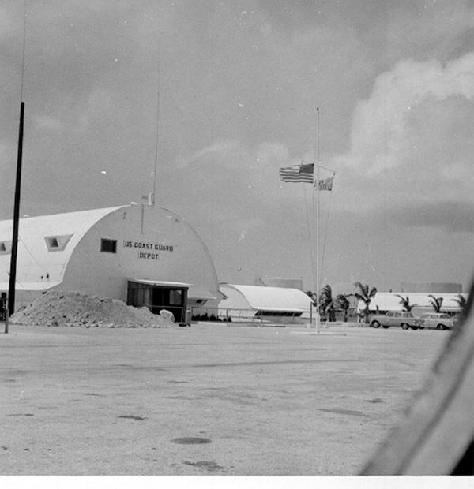 |
| Coast Guard Radio/NRV circa 1960 |
Soon after the American forces
regained the island towards the end of the year 1944, work began on the
construction of a communication station for the American Coast Guard. This new facility, under the callsign NRV,
was installed on Cabras Island, a long fingerlike peninsula projecting out from
the northern shore of Apra Harbor.
A Loran navigation station was built
at this extended location, and the Coast Guard radio station occupied a small
corner in a two storeyed Elephant Quonset Hut.
A 24 hour watch was kept by four radio men, each on duty for a period of
six hours.
Twenty years later, that is in 1965,
the NRV Coast Guard communication station was transferred from Cabras Island into ground level rooms in
Building 150 in the Naval Communication Station NPN at Finegayan. The transmitters in use for station NRV were
part of the naval transmitter complex at Barrigada, and generally speaking NRV
communicated via one of the 1 kW AN/FRT-70 transmitters.
Ten years later (1975). Coast Guard
NRV moved upstairs in the same Building 150, a location that is still in use to
this day. Soon afterwards, the Coast
Guard station in the Philippines began the
remote control of some
of the transmissions from NRV Guam. Then
beginning in 1994, Guam was remoted by Coast Guard NMO in Hawaii, and also by
NMC Point Reyes in California. The use
of Morse Code was dropped during the next year, on April 1, 1995.
Over the years, QSL cards and
letters have verified reception reports from listeners who have been fortunate
enough to tune in to this interesting and historic communication station.
During this same era of recovery
after the end of the Pacific War, an American forces mediumwave AFRS station was inaugurated under
the callsign WXLI, with 50 watts on 1380 kHz.
This station was launched in October 1944.
Then three months later, in January
of the following year (1945), the power level was augmented to 325 watts on the
the same mediumwave channel. At this
stage, AFRS Guam announced that a shortwave outlet for the same programing
would soon be introduced.
On March 18 (1946), more than a year
later, shortwave test broadcasts were noted in the United States with a relay
of programming from this AFRS mediumwave WXLI in Guam. These AFRS relays on shortwave were
transmitted from the newly revived naval radio station NPN, which was on the
air during that era under the tactical callsign KU5Q.
The studios for AFRS WXLI mediumwave
and U. S. Navy NPN-KU5Q were co-sited on Mt. Aluton, a few miles south west
from Agana. During this era, there were
many joint relays of AFRS programming on both mediumwave WXLI and shortwave
KU5Q.
It was at this stage that a mobile
broadcasting van was introduced to the radio scene on the island of Guam. This new radio van was operated by the Army
Air Force at Harmon Field, and it operated under its own callsign. KU5Q1. The usage of a callsign would suggest that
the vehicle also contained a mobile transmitter, which in those days would have
operated on a shortwave channel just above the mediumwave band.
For the past dozen years or more,
AFRTS Radio in Guam has been on the air on shortwave again, and via the
transmitters of the same NPN at Barrigada, near Agana. This program relay has been listed on two
shortwave channels as shown in the WRTVHB, 5765 kHz and 13362 kHz, at 3 kW on
each channel. A few QSLs for these
program relays have been issued, mainly to listeners in Pacific Rim countries,
and also to several countries in Europe.
Another communication station of
interest on the island of Guam was installed by RCA soon after the end of the
Pacific War. Initially, two transmitters
at 1 kW each were installed and these were allocated the callsigns KUJ and
KUK. These transmitters were
manufactures by RCA in the United States and they were identified as model P. The antenna beamed on San Francisco was a 730
feet long diamond shaped rhombic.
In the 1970s their equipment was
upgraded, and they were then using half a dozen transmitters at 20 kW, and
three more at a lesser power level. An
additional callsign came into use at this time, KUL.
RCA on Guam has operated with
offices and communication control at San Vitores Road in Tamuning, and at Ada
Plaza on the corner of Saylor and Aspinall Streets in Agana.
For a couple of years (1952 &
1953), RCA Agana was on the air with the relay of programming beamed to China
on behalf of a California based organization that was identified as Radio Free
Asia. The Guam relay picked up the
programming off air from California and it was rebroadcast on 9490 kHz.
In 1949, an international radio
monitor in the United States noted RCA Guam on 15476 kHz with the transmission
of phone calls from American servicemen on the island.
Over the years, QSL cards have been
issued by both RCA Guam and Radio Free Asia Guam, verifying their respective
transmissions.
The second generation Globe Wireless
in California also maintained their own maritime communication station on the
island of Guam. The transmitter station
was located at Yona, and the receiver station was located at Talofofo.
Globe Wireless KHF on Guam was a low
power operation that was functioning for maybe a score of years, until Globe
closed most of its facilities worldwide and sold off to a satellite
provider. The Globe Wireless KHF email
QSL card was indeed a very attractive card in full color.
More about the radio scene on Guam
in coming editions of Wavescan.
(AWR-Wavescan/NWS 368 via Adrian Peterson)